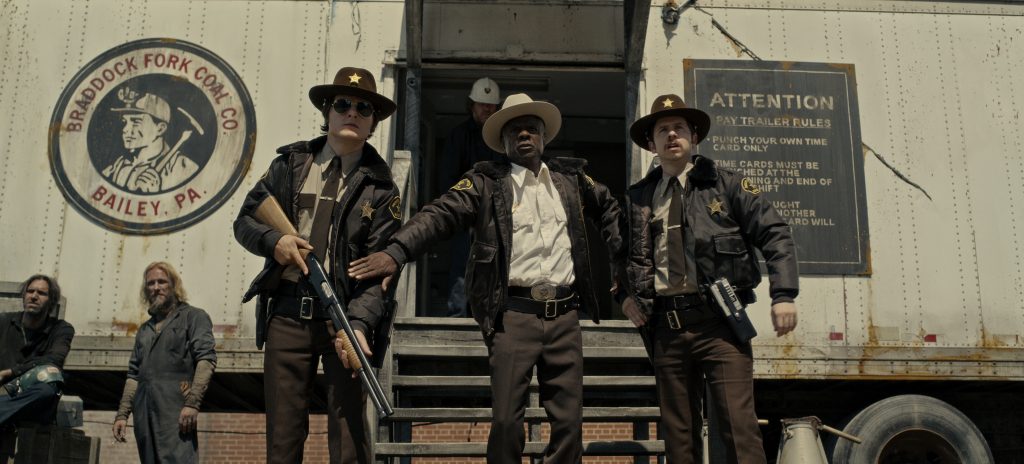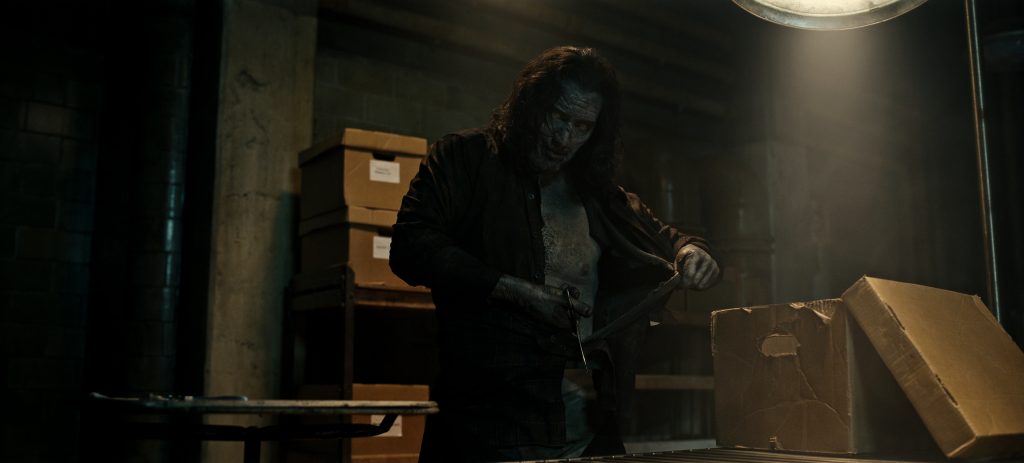Spine-tingling visuals
Anastas Michos ASC GSC reteamed with director David Prior to shoot the Emmy-nominated episode “The Autopsy” for Guillermo del Toro’s anthology series Cabinet of Curiosities.
In this version of Michael Shea’s short story, adapted with the help of screenwriter David S. Goyer, a small-town sheriff (Glynn Turman) is investigating a tragic mining explosion. One of the bodies pulled from the wreckage is given to pathologist Dr Winters (F. Murray Abraham) to examine, only to uncover a much more gruesome and macabre secret.
The episode, shot on RED Digital Cinema cameras, also received recognition with an ASC Award nomination earlier this year. Given the subject matter and their successful collaboration on Prior’s feature debut the horror film The Empty Man (2020) it was natural the pair should hook up.


“A director and cinematographer might not always see eye to eye but when they work together a lot you tend to challenge each other and that becomes part of the creative process,” says Michos. “You develop a shorthand which is paramount to getting through it all, particularly for TV. We shot this 58-minute episode in 15 days which astounded the both of us. Having the ability to understand what the director is trying to communicate is certainly useful.”
Knowledge of each other’s sensibilities proved advantageous when they arrived in Canada to shoot “The Autopsy” in 2021 during COVID since they were instantly confined to quarantine.
“We had about three weeks in our respective apartments which allows a lot of time to think. Our main reference for exteriors and tonality was The Deerhunter (1978). In most projects, tonality is the first thing we try and decide.
“’The Autopsy’ is both a horror piece and an existential suspense story. It’s about a dying man who recognises his own mortality and somehow discovers another being in the universe. That is what draw me to the story.”

In addition, Prior and Michos wanted to draw out the story’s neo noir elements and decided to use colour for this purpose.
“In television I tend not to shoot particularly dark because you don’t know what anybody’s TV set is actually going to display, unlike with the more standardised DCP for theatres when you can walk that line a little further. In this TV show we use colour to get into those noir tones.”
Michos says Prior has a “very strong sense of camera” in terms of what he likes and the way he works. “He is drawn to using camera with intent. The camera is never chaotic. It always has a beginning, middle and an end to every move. Which sometimes works outside the sphere of the actors.
“By that I mean he will change his blocking to allow the camera – the audience’s eyes – to set the tone and then adjust the blocking to it. If the actor misses their mark, he will instantly call cut.”


Michos also reveals that Prior regularly uses previz for scenes but doesn’t tend to share that with his camera crew. “He internalises the previz, but he also allows the shot to happen on set organically. When I go into rehearsal, I’m aware of how he likes the cameras to move and will set up shots accordingly, knowing that he also has previz in his mind.”
The opening scene is an example this. The transition from the stars to the mine, which glimmer like the night sky, was Prior’s idea in prep. It turned out to be half CGI (the stars) and half practical with the ‘coal’ composed of chunks of anthracite.
The spider’s web in the same scene came about serendipitously. Prior and Michos were on their way to location when they stopped to get a pick up shot by a riverside.
“The location was bucolic – too bucolic for what we needed. So, we jacked up the van, took the tyre off and put that in the frame. We littered in some coke cans we had in the truck and dirtied up the frame to be a little more industrial and appropriate to a mining town. In the process we noticed this beautiful spider web. You could barely see it since the morning dew had gone so I took a water bottle and squirted it and took the shot. David has always thought we might use a moth for this scene but Guillermo saw the web in dailies and suggested to that David go with the spider idea. The spider then becomes a motif through the rest of the show.”
The mine set and mineshaft were designed by production designer Tamara Deverell with removable walls to realise the desired camera movement and lighting.

“She designed the tunnel on paper and we paced it out on the construction floor and realised we had maybe 10 metres of tunnel with a bend in it. The sequence itself was several pages so part of the process was to make the tunnel seem longer.”
Working on a limited budget they employed the usual tricks such as lighting one side to film then turning around, lighting the other side and, by altering the background and judicious cutting, creating the illusion of a longer tunnel.
They used a Technocrane 75+ to reach into the tunnel but had to take it off its base because it was too high. Key grip Robert Johnson manufactured a ‘seat’ for the crane to sit on the floor and allow Michos to perform a tracking shot.
“The mine shaft is supposed to be 50 metres deep with an elevator travelling down, but our elevator only travelled three metres so that was a process of smoke and mirrors too. Since the elevator cage starts to descend from daylight we had to figure out how the lights would dim and where to put them for the shadows to work. The fall off had to be appropriate. One of our larger accomplishments was getting a 10ft drop to look like it went 10 storeys underground.”
They would have encountered different hurdles had they shot the scene in a volume. For a start, where do you begin to look for a mine which is period appropriate to the 1970s whose owners will allow you to film inside?
“It certainly can be done as virtual production and it’s a great way to do it on a TV budget but in this case the practicalities of doing it old-school worked out well.”


For their camera package Prior and Michos went with RED’s Monstro in concert with Zeiss lenses. They shot the episode in 8K and extracted a 5K picture for Netflix.
“We did a lens test and the Zeiss was the one we felt had the right bokeh. I also needed a fast lens because of our dark lighting scheme.”
Having started out as an operator on films like Interview with a Vampire and Mary Reilly and as DP shooting Texas Chainsaw (2013) and The First Purge (2018) it is hard to not to conclude that Michos seeks out horror and supernatural stories.
“Part the reason is the horror genre allows a filmmaker to explore the human condition in a very specific, stylised way,” he agrees. “It allows the cinematographer to challenge themselves more than a drama might, because a drama is placed squarely in reality. I find horror and supernatural more interesting to photograph because we can push the boundaries of reality.
“At the same time, I mix it up and go from horror to romcom to drama because on set we live the same lives as the characters. It is hard to be on set for 12 hours even pretending to cut into someone’s chest or dealing with death, destruction and fear and all that despair for day after day, so a change to a romcom is always welcome.
“I love telling different stories. Some are beautiful and loving and some are horrible and shocking but that’s the way of life.”










